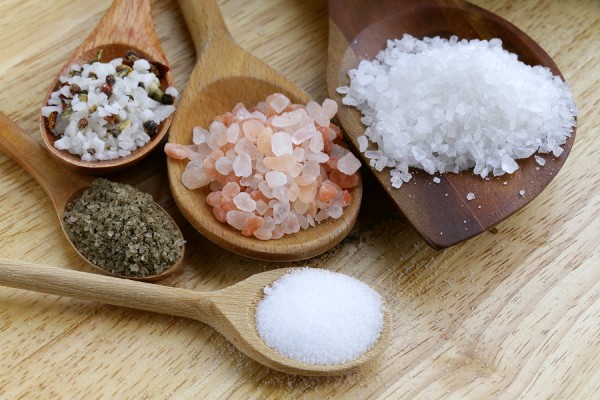Salt Sense: Which Type is Best to Use?

Our recommended daily intake of salt is one teaspoon, or less than 2300 milligrams (mg) of sodium. This comes from the 2015 Dietary Guidelines for Americans. But most people eat much more than 2300 mg. In fact, the average intake is more than 3400 mg per day. Too much sodium raises the risk of high blood pressure, heart disease and stroke.
Where we get sodium
Most of the sodium in our diets comes from processed foods, like canned soups and vegetables, cold cuts, hot dogs and salad dressings. Even some breads and cereals are high in sodium. In addition to processed foods, restaurant foods can also be high in sodium.
What about salt?
Salt is, of course, a source of sodium, and using less in cooking and on foods is important if you have high blood pressure. Most people can use a small amount of salt, however. But what type of salt is best?
Types of salt
There are many types of salt to choose from, ranging from the very basic to fancy, gourmet salts. Which is best, and are any healthier than others?
- Table salt. Also called iodized salt, table salt is fortified with iodine, a mineral that’s needed for a healthy thyroid. Table salt dissolves quickly and works well in cooking and baking.
- Kosher salt. Kosher salt is a larger-grained salt with a lighter, flakier texture. Professional chefs often cook with kosher salt. Because of its larger grain size, there is less sodium in kosher salt per teaspoon compared to table salt.
- Sea salt. Sea salt is made through the evaporation of salt water. Depending on the source of water, sea salt can contain a trace amount of minerals. These minerals give color to the salt. Sea salt generally has a coarse, crunchy texture and a distinct flavor. As with kosher salt, sea salt contains a little less sodium per teaspoon compared with table salt, due to its larger crystals. Fleur de sel (“flower of salt”) is a hand-harvested sea salt and is highly-prized by chefs and home cooks alike.
- Himalayan pink salt. This pale pink salt is available in everything from salt grinders to bath salts. Himalayan salt contains small amounts of mineral; however, despite claims about its health benefits, this salt isn’t necessarily any “healthier” than other types of salt.
- Light salt. Light salt is a blend of sodium chloride (basic table salt) and potassium chloride. Light salt contains about half the sodium of regular table salt. While this product can be helpful in cutting your sodium intake, it might have a more metallic or bitter taste than what you’re used to.
What about salt substitutes?
Salt substitutes, which contain potassium instead of sodium, can be a good choice for some people. However, if you have kidney problems, you should check with your doctor before using a salt substitute as too much potassium can be harmful.
The bottom line with salt is that there is really no difference, nutrition-wise, between the different types available. You’ll get slightly less sodium, per serving, with larger-crystal salts such as kosher and sea salts. However, all salt, except for light salt, contains 2300 mg per teaspoon. Use a small amount and boost flavor with other sodium-free seasonings, like herbs, spices and pepper.

